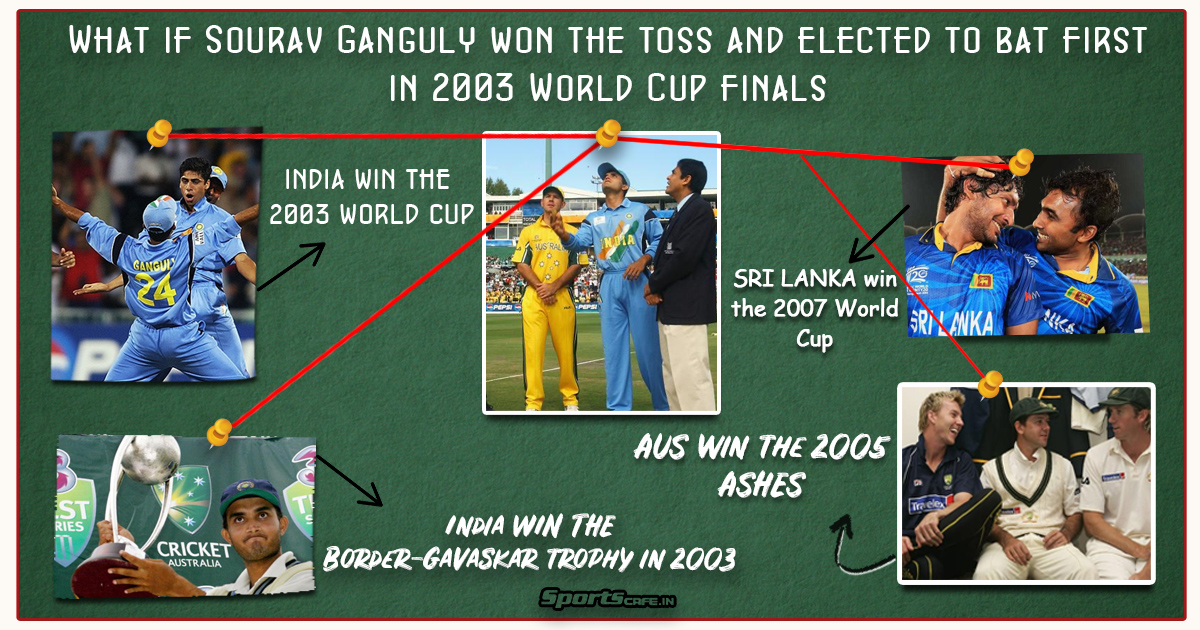What if Wednesday | What if Sourav Ganguly had elected to bat in the 2003 World Cup Final
What if we tell you that a simple toss decision from Indian skipper Sourav Ganguly in 2003 would have led to the most dramatic of events, that of Sri Lanka winning the World Cup in 2007? Sounds crazy, right? Well, hang on and find out how a millisecond on March 23 would have reshaped history.

On March 23, 2003, India were one step away from winning their second Cricket World Cup under the leadership of Sourav Ganguly, facing Australia in the cruellest of contests. India, on the back of their wins over Kenya and Sri Lanka, entered the finals against Australia. Ganguly, on the day it mattered the most, won the toss and elected to field first. But what if the then 30-year-old had won the toss and elected to bat first instead? Well, let us dive right in and find out what would have happened!
Batting first, Australia dominated the proceedings in a one-sided final at the iconic Johannesburg, where the Indian bowlers struggled initially. Adam Gilchrist, Matthew Hayden, Ricky Ponting and Damien Martyn all out batted India on the day with pacers accounting for 211 of the 359 runs posted by Australia. Hold on, stop and wait for a second, what would have happened if India had won the toss and batted first? Coming into the encounter, Sachin Tendulkar and Sourav Ganguly were in prime form. The southpaw had scored 441 runs in ten innings, while Sachin had 669 for the tournament in the same number of innings.
On a batting-friendly deck in Johannesburg, the Indian openers got off to the best starts possible without any pressure. Sachin and Sehwag posted 100 runs for the first wicket, with Sehwag the first one to get dismissed in the 15th over of the innings. From then on, it was a Ganguly and Sachin masterclass - with the duo putting on a 150-run partnership for the second wicket. Ganguly fell soon after India had posted 260 runs on the board. And then walked in Mohammad Kaif. India’s 2001 Natwest series heroes Kaif and Yuvraj Singh went berserk, as Kaif added 30 runs in 20 deliveries while Yuvraj went crazy, scoring 22 off just eight deliveries.
In the end, India scored 323 for the loss of three wickets, with Sachin top-scoring with a 130 as his golden form with the bat continued. Chasing 324, Australia were put under immediate pressure with Zaheer Khan picking up the early wicket of Gilchrist. From the other end, Javagal Srinath’s overs added pressure on the chasing Australian side.
However, it was Ashish Nehra who struck with the wicket of the Australian skipper, Ponting, from where on the game was a landslide for the Aussies. With Ponting’s men short of middle-order prowess, India and Nehra capitalised with two more wickets as Australia came crashing down at 70/4 in the final. Harbhajan Singh’s spell ensured that India walked away with the 2003 World Cup trophy, their second since 1983. Ganguly, Dravid and Sachin all won their World Cups, which was the first for them. Meanwhile, the Australian side were left dejected following an abysmal batting display in the second innings. That meant that Damien Martyn and Shane Warne, who was banned got the axe while Darren Lehmann and Michael Beaven retired.
India’s tail was already wagging, and they visited Australia down under in the same year. Shane Warne, following the bad performance, never found himself a spot alongside Martyn. Without Martyn in the middle-order, Australia lost the Border-Gavaskar Trophy making Sourav Ganguly the first modern-day captain to win in Australia, not Virat Kohli. India’s ODI form, too, was impressive, posting wins in the TVS Cup, thanks to the absence of Martyn. However, they lost the VB series in 2004 and posted a victory over Pakistan in the same year. Slowly, India were becoming one of the best sides in the World and dominated the ODI rankings.
Australia's comeback with an Ashes victory:
In the 2004 Champions Trophy, it was West Indies who had the final laugh after their win over England in the final. Earlier in the tournament, Australia fought England in the semi-finals, where they missed the chance to win their first ODI title since 1999 World Cup. England, too, scuffed their chances in the final against West Indies. Both sides, terribly disappointed and dejected, faced each other in the 2005 Ashes series. Australia, however, had a point to prove after the terrible Champions Trophy and so called Warne back into the squad. In the absence of Martyn, they brought in Clarke and Brad Hodge into the middle order as well.
Hodge’s brilliance in the domestic circuit helped Australia in the Ashes alongside the return of a resurgent Warne, leading them to a 2-1 victory over England in the series, which meant that England had to wait for the next Ashes to lay their hands on the trophy. Following the series, Michael Vaughan and Ian Bell were dropped from the English setup, with Andrew Flintoff being made the new skipper of the English side.
In between the Ashes series and the next ODI series, the world champions and No.1 ODI side, India, hosted World XI in three ODIs and a solitary Test. For India, Sachin Tendulkar made the most of the tournament, with a debut to MS Dhoni in the series. Dhoni became the find of the tournament, replacing Rahul Dravid, being the wicket-keeper for the team, while Dravid continued as a specialist batsman. Australia’s next series came against South Africa, with Shane Watson having already made his mark in the domestic circuit. With the debut of Shane Watson in the ODI series, Australia regained confidence with a series victory over the South African side in the 2006 series, with Mick Lewis never being part of the squad. With McGrath returning in time before the ODI series, they won the series 3-2 after South Africa’s dominance in the first two games, with Shane Watson being a crucial plugin for the Australian setup.
Lewis' absence also meant that Australia did not concede 113 runs in ten overs, in South Africa’s run chase of 434 in the series finale and with Watson in the team, they had an extra bowler. Australia started threatening India at the top of the ODI rankings, which they eventually attained in 2006, after impressive displays in the ODI series against New Zealand, in the VB series and Bangladesh.
What is up with Sri Lanka:
Meanwhile, away from the limelight, Sri Lanka were slowly building up momentum with wins of their own. After their terrible loss at the hands of the World champions India in the 2005 series, they made a few vital changes to the side. Marvan Atapattu was immediately dropped from the team, with Mahela Jayawardena made the new skipper. And, the result was immediately visible with a 5-0 whitewash over the 2004 Champions Trophy finalists England in what was the starting point of the changing fortunes for the Island nation. Under Jayawardane, they went on to play the 2006 Champions Trophy. In the Champions Trophy, they got off to the best starts, winning three games in the group stage.
Added to that, in the knock-out stages, they won twice against Pakistan and New Zealand to enter the semi-final stage of the tournament. In the semi-finals, they faced the wrath of the Australian side, who steamrolled them to a 60-run victory to face the West Indies side in the final. The Australian side won the final, convincingly, with Shane Watson being named as the ‘Man of the match,’ following his impressive show in the tournament. Australia, having won the Champions Trophy, were eyeing for a win in the 2007 Cricket World Cup. And Sri Lanka were coming on the back of their series win over New Zealand in 2007, with Chaminda Vaas, Sanath Jayasuriya all putting up a strong show, after the disappointment against Australia earlier in the Champions Trophy.
In India, they won the series with the emergence of the partnership between Nuwan Kulasekara and Lasith Malinga with the ball. With the bat, Upul Tharanga and Jayasuriya created havoc at the top of the order for the Island nation against the 2003 Champions. They already looked like a side to beat, with the bowling looking so dominant, with only Australia holding an edge in that department. Tharanga and Jayasuriya at the top of the order changed fortunes for Sri Lanka in the Cricket World Cup. In just the first game, they thrashed Bermuda by 243 runs before facing the 2003 World Cup winners India. In that game against India, too, they were dominant from the word ‘go’ and won the game easily. They put on dominant displays throughout the tournament, winning five out of the seven games in the Super Eights. In the semi-final, they had an easy task of dismantling the New Zealand side, which meant that they played Australia in the final. With Kulasekara in a prime form before the tournament, they just needed one good game against Australia to win the tournament.
Australia won the toss and elected to bat first in the final. Immediately, they were put under the pump with the wicket of Adam Gilchrist off the bowling of Nuwan Kulasekara. Australia then crumbled under the pressure of facing Malinga in the powerplay overs. Later on, it was the off-spinner Muttiah Muralitharan who picked up wickets in the middle overs to dismiss Australia for 212 at the end of 38 overs.
Sri Lanka, in the run chase, got off to a bad start, with only Jayasuriya hitting it across the boundary. A partnership between the two got the Jayawardene-led side closer to victory. However, the final blow was inflicted by Kulasekara himself. Tait, bowling in the 35th over of the innings, bowled one wide outside the off-stump and Kulasekara cleared the boundary with a dead-straight hit. With that, the wait for a Sri Lankan victory in the World Cup was over and two Asian sides - India and Sri Lanka - became the kings of World cricket with the Lankans winning the 2011 edition in the sub-continent.

Comments
Sign up or log in to your account to leave comments and reactions
0 Comments